Early puppy training is fundamental and I didn’t want to make the same mistakes my parents did with their different dogs.
The character of the westie can frighten at first sight, by its stubborn side – it is a terrier… However, he is one of the breeds that are rather easy to train, if you apply the right method.
In this article, you’ll learn the 10 essential principles for training a dog, whether it’s a westie or another breed.
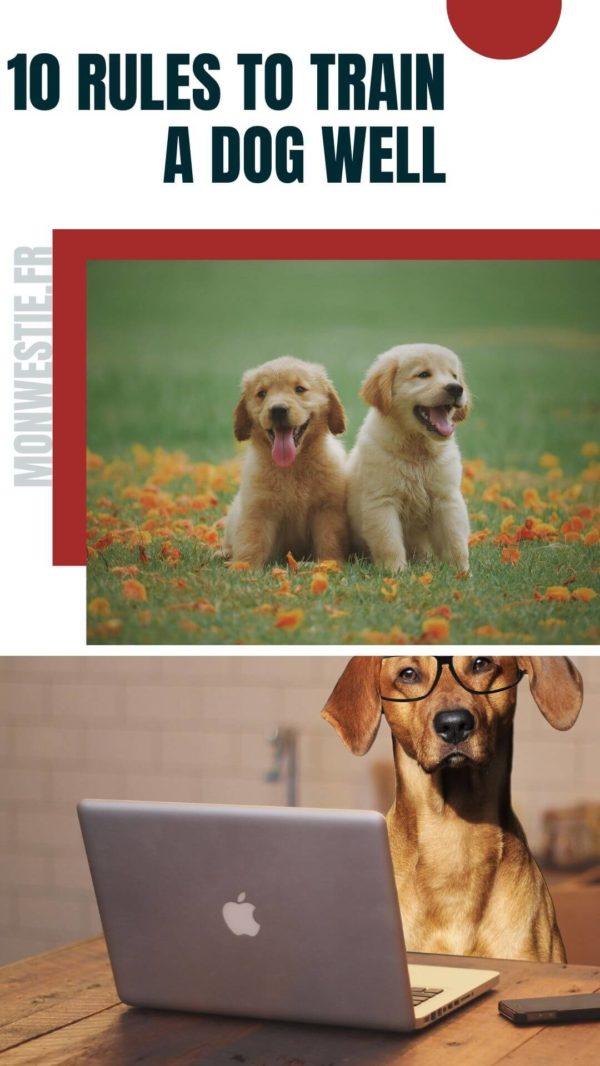
Prerequisite: educate or tame?
In French, we often use the verb “tame” instead of “educate” or “train”. I don’ like this verb at all for the education of a dog, as it implies a kind of control or domination on the dog. For me, the term “taming” – “dresser” in French – implies the search for the docility of the dog. The term “education” corresponds better to the relationship I wish to establish with my dog, which respects his personality and his character without “enslaving” him.
Similarly, you will notice I never use “it” but “he” as an animal is not a thing.
You may want to learn how to train a dog because you have a particular need: guide dog, security dog, etc. The training techniques will obviously be more advanced and the dog’s future function requires that he be effectively docile.
For a pet dog, I prefer to use the term “educate”.
1. Learn early puppy training.
I prepared the arrival of Jahan like the arrival of a baby, that is to say by researching for many months to try to make as few mistakes as possible.
I first inquired about the breed, to be sure that the one I had fallen for, the westie, really suited me. I have to say that I had always been rather attracted by medium-sized dogs and that I found small dogs surly and not very interesting…
I then bought and read several general education books on dogs and a book on the westie.
Click on the photo or links below to read reviews and buy.
The power of positive dog training
The West Highland White Terrier
This article contains compensated links. As an Amazon Associate I earn from qualifying purchases. Consult the disclaimer on the site for more information.
I also read tips on different websites, watched videos on YouTube.
This preparation time allowed me to welcome Jahan in the best conditions.
2. Familiarize the puppy with his new environment.
Your puppy arrives in a new place and meets new people.
Jahan was lucky enough to grow up seeing me every Wednesday before he moved in. The first time was the day after he was born! So he was perfectly used to me, he even expected my visit every Wednesday.
Yet, when he found himself out of his stall and I put him on the breeder’s desk for the formalities, he didn’t dare turn his back on me to sniff around. I remember him walking backwards!
The car ride can also be a discovery for your puppy. I went to pick up Jahan with my mom, so I could keep him on me in the car. He was not very reassured and we stopped after a few kilometers so that he could do his business.
Familiarization with the apartment I was living in at the time went quite well. There were toys waiting for him, including the one given to him when he was still at the kennel, a basket and a cage for sleeping.
If your puppy is introduced to more than one person in the household at the same time, it’s important to reassure him and start gently.
A new environment and a new family is a lot of emotions at the same time for a young puppy and it is likely that he will quickly fall into a deep sleep.
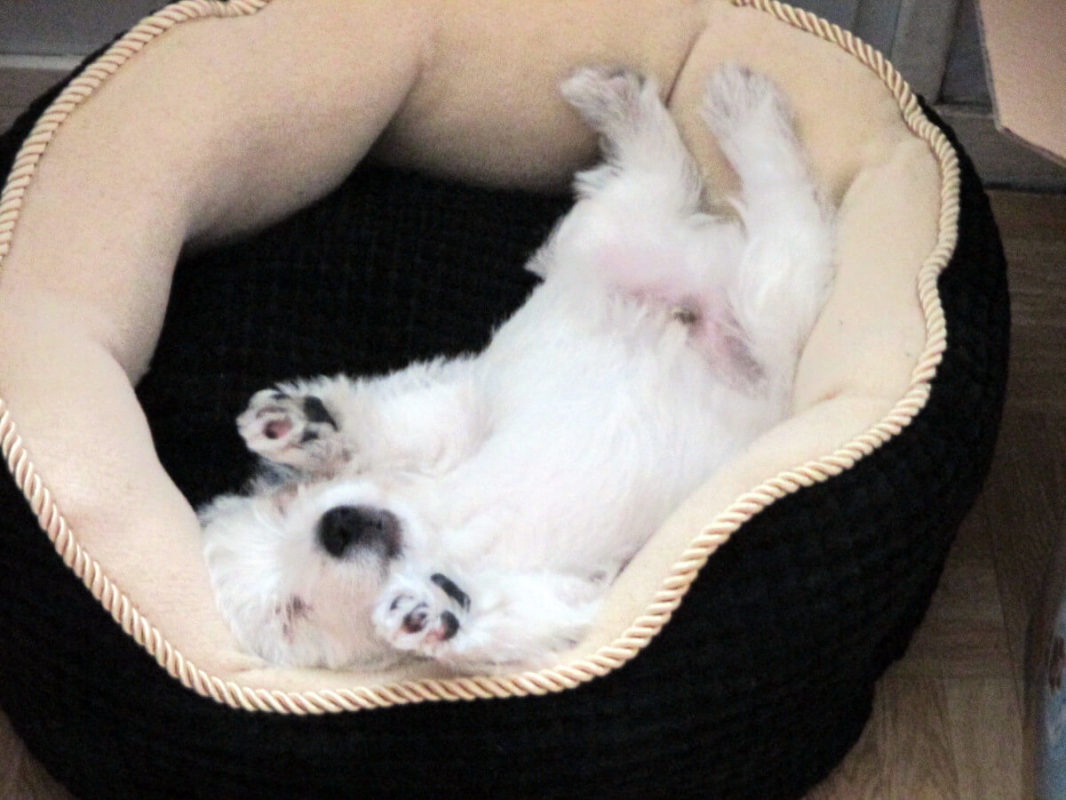
You can see that I had provided a round padded basket, well surrounded. He used to sleep next to his mom and sister and I wanted him to find that feeling. I chose one with a detachable and washable cushion. The cat who joined him a few weeks later quickly took to the basket…
Even today, 7 years later, Jahan uses the pillow to put his head up when he sleeps in his cage!
The first days, avoid leaving him alone. He has lived in a group, at least with his mother, until now. It is better to get him used to your absence little by little.
3. First things to teach a puppy: How to potty train a westie puppy?
I will certainly do an article dedicated to this subject.
It was quite easy for me to potty train Jahan. At night, he slept in his crate and a puppy will never dirty his bed. You will notice that I put old clothes with my smell, his toys and his water, in order to place him in a reassuring environment.

During the day, I often took him out in the garden of the residence and took him for a walk.
4. Be the pack leader.
If you want to train your dog in good conditions, he will have to recognize you as the leader of the pack.
To do so, 3 things are essential:
- Firmness.
- Consistency.
- Short orders accompanied by a gesture.
In summary, set rules (firmness), explain them to your dog (short commands + gesture) and stick to them (consistency). This is how you will gain your dog’s respect and trust.
In the absence of rules, your puppy will want to take “power”. He will see himself as the leader of the pack, which will inevitably lead to behavioral problems (fear, aggression, etc.).
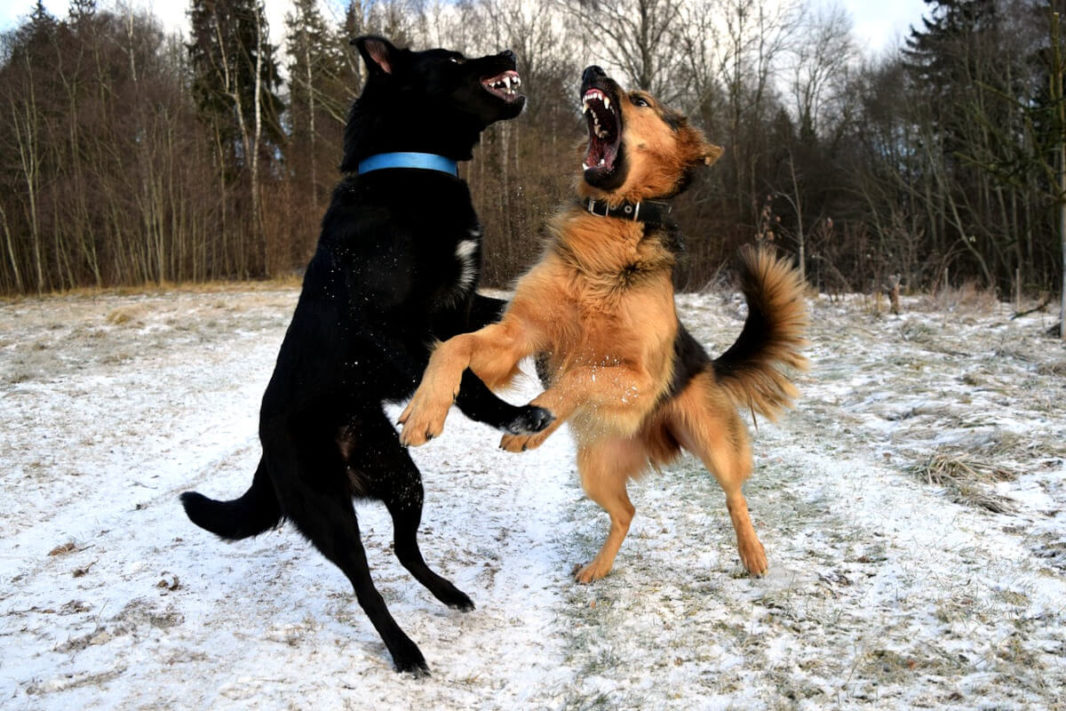
A while back, I talked to a couple whose westie dog rules. Every night, she wakes them up to look at the moon. Her owners systematically give in and they get up exhausted every morning.
Westies are very smart little dogs and they are very good at making everyone melt. It is imperative to be firm from the start if you don’t want to become a slave to a temperamental dog.
A tip from a dog training professional: for the first few days, put your puppy on a table and stand facing him, looking at him, to show him that you are in control. Or simply lay him on his back on your thighs and pet him on his belly while preventing him from turning or standing up.
5. How to educate your dog without shouting. Training without violence.
When a dog doesn’t obey, most of the time it’s because he doesn’t understand what his owner wants from him.
We all regularly come across dogs walking their owner on a leash. However, it is not complicated to teach your dog to walk on a leash and to heel. Jahan learned both at the same time when he was only two months old and we were living in the city!
Regularly when we go for a walk in Biarritz, dog owners are delighted to see Jahan walking alone near me.
In town, when we cross, Jahan waits for me to give him permission. Walkers and drivers are always surprised to see him stop and wait when there is a two-step crossing.
A few months ago, I taught him to pose for pictures, whereas until now I could only “steal” a few pictures when he wasn’t moving.
Our secret: I explain to Jahan what I expect from him! You can’t expect your dog to spontaneously learn to walk on a leash, just like I realized a little late that photo posing was something I could teach my dog.
Use positive reinforcement. Positive reinforcement works especially well with westies, who love to be praised.
Simply praise your dog whenever he spontaneously does something you want to reinforce.
For example, for the photo pose, I started to congratulate Jahan by telling him “Bravo photo” as soon as he sat quietly in front of my lens. From now on, he often puts himself in the field of my camera without my asking him! Otherwise, I show him my camera, my camcorder, my phone, saying “photo”.
Praise him with great enthusiasm.
Show him that you are really happy that he did what you asked. Exaggerate the line so that there is no ambiguity.
You can give him a reward treat, pet him, kiss him and why not do a happy dance, especially if it is something difficult to learn and remember!
Don’t forget to tell him why you are praising him. For example, “to heel, good” or “crawling, good”.
Associate a gesture with the word.
For example, the outstretched hand palm down for commands like “down”, “sit”, “don’t move”, “don’t jump”. The left index finger pointing to the ground – next to your foot – for commands like “heel”, “side”, “curb”.
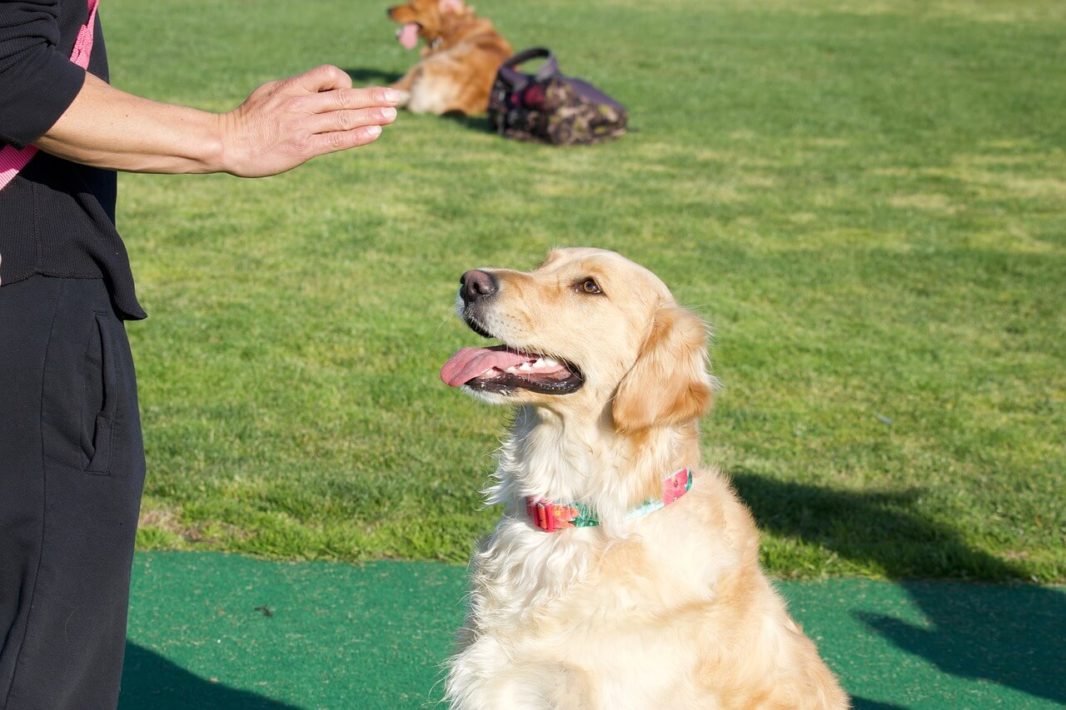
Use your dog’s natural inclination to please his owner.
The westies are in total adoration before their master. The more he loves him, the more he wants to please him.
They are also very proud little dogs. So praise works particularly well with them.
He also loves to be encouraged, especially when he can’t jump on the bed or you on the first try.
Use the game.
Like humans, dogs learn best by having fun. Try to bring a playful side to learning.
6. What to do if my dog disobeys?
Getting upset will most often not help.
It’s best to try to give the command again. Your dog may not have heard it correctly. Try using a different word if it is for a command that is not yet integrated.
Show your disapproval to your dog, by your gestures, your displeased face, your firm tone – no need to shout – and tell him “I am not happy”, “not good”, “naughty”, “not nice”, “nonsense”, “no”.

As a last resort, add to these signs of disapproval a hand on the skin of his neck and shake it very gently. This is how a mother dog “scolds” her pups. Or put him in a submissive position if he is in his teens or particularly stubborn.
When he is older and more obedient and does something wrong, you can punish him for a few minutes to show your disapproval. On the rare occasion that Jahan does something stupid, he will spontaneously go to the corner!
Once your dog understands that he has done wrong, you can ask him to give you a kiss. This is a sign of submission for the dog and therefore a good way to see if he continues to rebel.
7. Build a relationship of trust.
Your dog needs to feel that you are watching over him and that he can trust you completely. Once he has that trust, getting you to obey him will be a breeze.
Jahan’s first visit to the vet went very badly. It was a simple introduction visit, but he didn’t want the vet to touch his buttocks. So he pretended to bite her. The vet calmed him down and tried twice. At the third refusal, with my agreement, she put him in a position of submission. Jahan was two months old. Yet he screamed and struggled for almost 20 minutes! Once he agreed to submit, the vet put him back on his feet and Jahan licked her to show his submission. Since then, he loves to go. As soon as I pull into the parking lot of the clinic, Jahan is all excited, crying, screaming with joy and running with the utmost impatience to the front door!
In conclusion: your dog needs to feel that there are rules and that you know what you are doing. It is not because you are going to impose these rules to him that he is going to like you less, on the contrary!
The reverse is true. The more your dog feels that you trust him, the more he will flourish.
8. Interactions with other animals.
From a very young age, since Jahan was vaccinated, I put him in contact with as many different animals as possible.
At home, he would play with a neighbor’s cat whenever I took him out to do his business. So much so that I got a cat for him when we moved into our house.
I took him to the mountains to show him the sheep, cows and pottoks.

When we walked along the ocean in Anglet, I didn’t tie him up. As soon as he saw a dog, he would look at me to see if he could approach or not. Depending on my nod, he would greet the friend or not. Now, he is able to see by himself if it is safe to approach or not. And since he knows that I am there to watch over him and intervene if necessary, he is not afraid.
The one thing you should never do is hug your dog as soon as you see another dog, just because he is small. You will only instill in your dog a fear of other dogs, which may well translate into aggressive behavior towards them.
9.Interactions with other humans / children.
Let your dog meet as many different people as possible: with glasses, a hat, on a scooter, with a surfboard… The sooner you get him used to all kinds of people, the less fearful he will be.
Also put him in contact with children quickly, both so that he gets used to gestures that can sometimes be brusque, and so that he too learns to be careful in his games.
10. Get him used to the sounds.
Some unusual noises can be disturbing to a dog.
With Jahan, I used the trick of a friend who also has a westie: during the first storms, I sang, played with Jahan. In short, I behaved in such a way that he understood that everything was fine. He was never afraid of thunder and lightning.
To go even further.
That was only early puppy training. I go farther with Jahan.
He is an integral part of my home and it is very important for me to show him that I respect his personality.
This respect requires certain things:
- Accountability. When he was 3 years old, we went to keep a Cairn Terrier dog in Saint Paul De Vence, Coco. Her owners did not impose any rules on her, Coco could not be let free and she did not know how to walk on a leash properly (her owners even used a lanyard!). I tied the two dogs together and it was Jahan who led Coco. He took the right side – the master’s side – and refused to let Coco change sides. He would pull her when she got too close to the road. He was very proud to feel empowered and our relationship grew even stronger. When he got tired of taking care of her, he would take the leash off the handle that was around his neck.
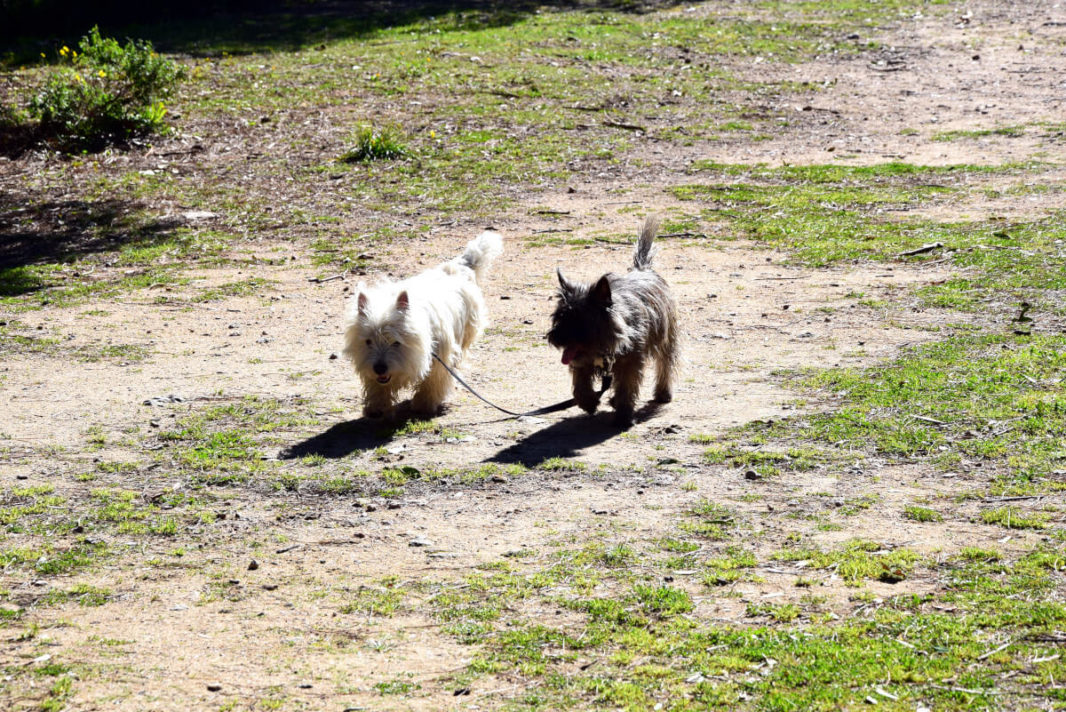
- Freedom. To be able to interact with the people and animals he chooses. Even if I encourage him for example to let the pottok babies approach him, I don’t force him.
- When we receive dog treats as gifts, if there are several kinds, I let him choose by presenting him with both. He immediately understands the principle of choice and lets me know his choice by moving the package that interests him, or by leaving with the treat of his choice. When he makes a mistake, he puts the treat on the ground to let me know he wants the other one.
- I consider that, like us, he is free to want to do something or not. For example, even though he is extremely clingy and cuddly, sometimes he doesn’t feel like giving me a hug or a kiss. I accept and respect his choice.
- The knowledge of the other. Jahan knows very well the difference between an order that he must obey and a simple request that he can decline. He is also very good at communicating his needs and desires. When he stands in front of the door, I usually know from his way of acting if it is to go out or to have a hug – hey yes, pavlovian reflex: he quickly understood that before opening the door, I systematically gave him a kiss or a hug…
Frequently asked questions about dog training.
You can find here a classification of the breeds according to the ease of education.
It is quite possible to train a two-month-old puppy. It is even recommended to train your puppy as soon as possible.
I am against the training collar. It’s the owner’s job to learn how to train his dog, not the dog’s job to adapt to his owner’s deficiency.
As for any dog, with a lot of patience, love, reassurance, softness…
For me, a westie is not tame; he is educated! Read my full article to learn the 10 main principles of dog training.
Yes, it is possible, but it all depends on how easy it is to train the breed and the temperament of your dog. In my opinion, even with a positive education, it is possible to punish your dog without violence – put him in the corner for a few moments. This gesture will show the dog that he is not acting well. Remember that your dog only has you and should not suffer from being deprived of his owner. This is not the purpose of punishment. Punish him only when you catch him in the act. Otherwise, he won’t know why he’s being punished.
Yes, although the westie is very attached to his owner, he can be left alone in the house. Get him used to it gradually, and give him plenty of room to drink, play and rest.
The westie is a dog that communicates a lot, through growls, cries, sighs, barks. You can scold him when he barks for no reason or too much. But you can also simply tell him that you have understood his message and he will often stop spontaneously. Don’t forget that a dog can’t talk and that his barking is a way of communicating and/or warning his master.
Conclusion – Early Puppy Training.
It’s not easy to know intuitively early puppy training and I made some mistakes myself with Jahan. On this subject, you can read my article about the growling dog.
Educating your dog takes time. Even though I have spent more than 7 years with Jahan, we are still learning from each other.
In summary, you should easily achieve this by following these 10 principles:
- Learn early puppy training.
- Gently familiarize the puppy with his new environment and the people in the home.
- House-train him with his crate.
- Become the leader of the pack.
- Train him without shouting or violence.
- Show your disapproval when your dog disobeys.
- Build a relationship of trust.
- Bring him into contact with other animals.
- Bring him into contact with as many different people as possible, including children.
- Get him used to unusual noises.
Do you have any other dog training tips or questions? Feel free to tell us about it in the comments below!
For more articles on dog training, visit this section
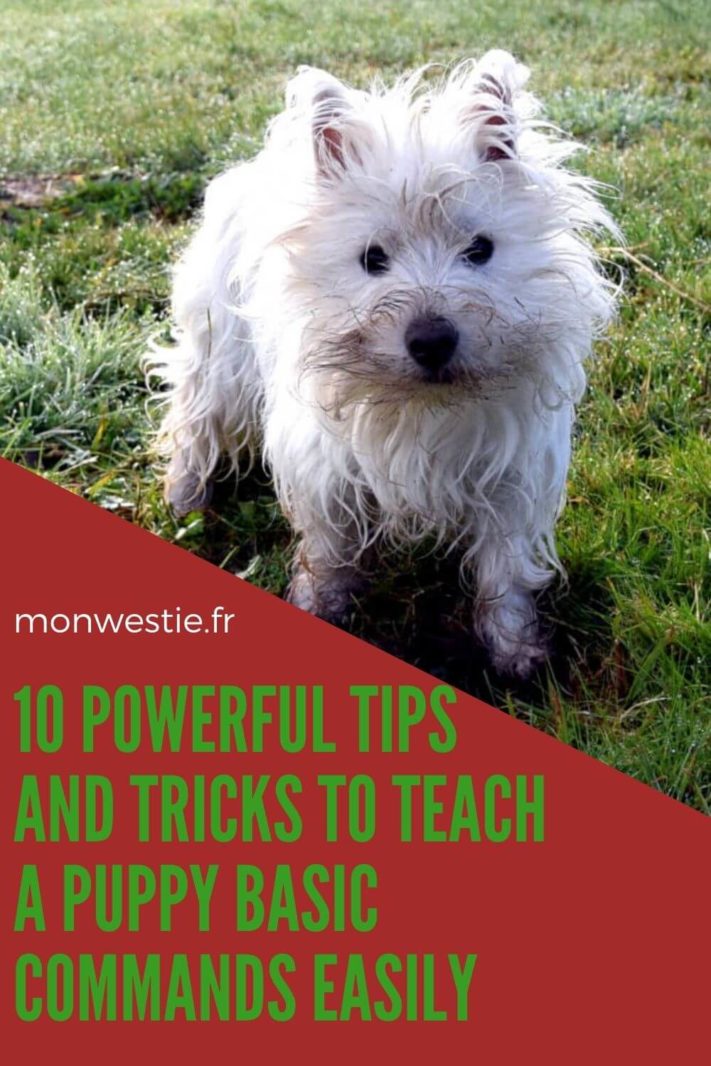
Good day from frenchie society.
I’m actual thankful for such a well made article.
As frenchie owners, we rank such read-out.
We believe that every news will make our world a better place.
We appreciate your job, progress like that.